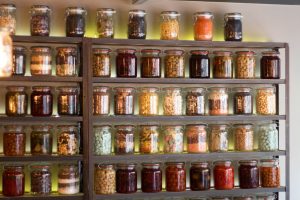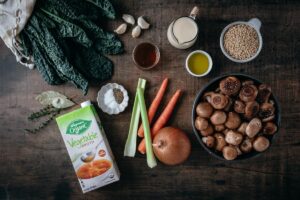I really thought I was prepared for this diet. I’ve lived without dairy and gluten for several years (making exceptions for birthday cakes–I am only human!) I knew many of the cooking skills required (fermenting veggies, making broth…) I’m accustomed to not eating the things that the rest of the family is eating. I thought I would be starting off ahead of the game. That was not the case.
My friends, I had my butt kicked by GAPS.
It’s a cruel irony that by the time I felt desperate enough to give GAPS a go, my body was entirely depleted. I knew I would need help with the cooking. Thankfully, I have a stash of delicious meals in the freezer to give to my family, so that I don’t have to cook for them quite so much. And I decided to pay a friend to get my fermented veggies going and cook broth for me (gallons of it, for days at a time…she is a treasure!) And the dear Linda has been such a valuable resource to me that I encourage anyone in Northern Colorado wanting to do GAPS to get in touch with her.
I also gave myself a lot of space for that first week. My dear Sweetie Pie husband had taken the week off from work and we had planned a stay-cation. Nursing me on my first week of GAPS and caring for the kids wasn’t exactly the stay-cation we’d had in mind, but I’m not sure I could have made it through without the extra help.
I chose to start off with the GAPS Introduction Diet. This phase is listed as optional, but Dr. Campbell-McBride notes that those who choose to skip the Introduction Diet and go straight into the Full GAPS Diet often suffer from lingering health problems that become difficult to address. Some folks choose to just start with the Full GAPS Diet, and then, once they’re feeling comfortable with GAPS methods and concepts, go back and do the Introduction later. Some folks never do the Introduction at all and get the results they’re looking for. However, I knew that with my severe and long-term digestive troubles, the GAPS Diet would do me absolutely no good until I’d done the Introduction.
The Introduction Diet is designed to heal and seal the gut lining quickly. How quickly you move through the Introduction Diet depends on how severe your distress is. Some will take a quick sprint through Intro, in a matter of weeks. Others (like me) will take a long, leisurely walk. Because of this, and because everyone approaches GAPS with different goals, what I outline here is what GAPS has looked like for me. It will look a little bit different for every person who decides to “do GAPS”.
The Introduction Diet is divided into five stages, stage one is the most severe and as you move through the stages you add in more “challenging” foods. Personally, I spent an entire week on stage one. I actually would have spent longer there, because I wasn’t entirely sure that my gut was ready to move on. But somewhere in my research I ran across a comment from Baden Lashkov (who wrote the GAPS Guide) that stage one should never last more than seven days. “You have to move on,” she says.
In stage one, your diet relies heavily on homemade meat and bone broths. These stocks provide building blocks for your gut lining, and they are so soothing to inflammation in your gut. Your stock needs to be made with the best quality meat and bones you can afford, using all parts–joints, bones, giblets, and even chicken feet if you can get them. All these parts provide such wonderful nutrition for your tummy. Don’t even consider skimming off the fat. Your body needs that fat, and it is so good for you.
Remember that GAPS utilizes three approaches to healing: diet, supplements, and detox. My diet, for stage one, consisted of the following (a bit bleak, I know) Dr. Campbell-McBride notes that all food should be heated on the stovetop (microwaves destroy nutrients among other things)
- soups made from meat and bone broth. In the early days, these soups were entirely broth with just a few chunks of meat in them. Slowly, over the course of the week, I added veggies and herbs to the soups until by the end of the week it was a pretty darn good soup–or at least it would have been if I wasn’t eating it for breakfast, lunch, and dinner. The veggies are very finely chopped and well-boiled so that they are soft and easy to digest. I also started adding coconut oil to my soup, which was super tasty and is entirely GAPS legal (and also aids in detox)
- “tea” made with sliced ginger and lemon, steeped in a pot
- 1 teaspoon per day of “juice” from the fermented veggies. My friend supplied me with a jar of sauerkraut, fermented carrots, and fermented beets. They are all delicious. I found that this little sip of juice became my “treat” of the day–the change of flavor that I looked forward to. These juices not only provide tons of probiotic bacteria, but they will also help restore your stomach acid production. Tasty as it is, it is potent stuff and you have to build how much you’re able to handle gradually. This is why it’s recommended to start with only 1-2 teaspoons per day. Since the veggies themselves aren’t well-cooked, only the juice is allowed at this stage. I added a few teaspoons of filtered water to the jars as needed, to keep the veggies covered.
- on day one I finished off some allergen-free treats that were in the cupboard. I mean really, am I supposed to let them sit there for the next two years, hoping I forget they exist?? Not likely. I ate them up with relish and now they don’t bother me.
GAPS doesn’t recommend starting all supplements immediately, so I am moving into my supplement routine slowly. Here are the supplements I took during week one:
- Hydrochloric Acid before meals, as a digestive aid. HCl is recommended for some people on the GAPS diet. Many GAPS patients don’t produce enough stomach acid, and HCl acts as a kind of artificial stomach acid, helping to digest food. It’s not recommended that you begin your diet taking HCl, but my naturopath already had me on it and it was obviously helping me, so I continued with it.
- Probiotic; again, it’s not recommended that you begin your diet taking a probiotic unless your body is already accustomed to it. This was a huge source of trouble for me in week one. Since I’d been taking probiotics for years, I assumed I would be okay continuing with it. However, I was coming off of an antibiotic and my naturopath had given me a super-strength probiotic to be taking. The combination of the super-strength probiotic and the detox my body was getting through diet was way too much for my poor body. I felt positively horrible for days. It finally occurred to me to split the probiotic, taking half in the morning and half at night. As soon as I did this, my symptoms became manageable.
- prescription meds for ulcerative colitis; I’m hopeful that eventually after some healing has taken place, I can come off of my meds. But for now, I thought it prudent to continue taking them. They do control some (but not all) of my colitis symptoms, and for that I’m grateful.
The only detox recommended at this stage is a daily bath. Add baking soda or Epsom salts to your bath water to draw out toxins. Ideally, rotate the two so that you have Epsom salts one day, and baking soda the next.
And, of course, you’re wondering how I felt. Horrible. The first three days were the worst. I was in bed with every digestive distress symptom imaginable. If you’ve ever had to do the prep for a colonoscopy, that’s what it felt like–for three days. As I said, Week One kicked my butt.
I also struggled with convincing my brain that my body was not, in fact starving. A brain that is used to feeding off of carbohydrates and sugars, that is suddenly getting none of them, naturally thinks it is starving. It takes a while, but a brain can actually be “retrained” to feed off of fat instead of glucose. (Nerdy tidbit: This is the basis of the ketogenic diet, which is often used to treat epilepsy. However, since GAPS reintroduces carbohydrates and glucose in the form of fruit and other natural sugars, GAPS is not a ketogenic diet.)
But towards the end of the week, I began to improve. The worst of my digestive symptoms subsided, leaving only the bloating and abdominal distension that has become my norm (picture a four-month pregnant belly on an otherwise very skinny girl). Fatigue and brain fog, typical side effects of the die-off of bad bacteria in the gut, also stuck around for the entire week.
So while Week One did not leave me singing the praises of health and wellness, I find myself at least a step or two ahead of where I was at the beginning. No pain? It was hard won, but I’ll take it.
Basic Meat and Bone Broth
http://www.plantoeat.com/blog/2012/04/gaps-introduction-diet-week-1/ <br>This is an essential GAPS recipe–the foundation for nearly all of your GAPS meals. There are literally thousands of variations on this recipe, but this is how I make it. <br>Use the best quality bones and meats that you can possibly afford. I’ve written this recipe for chicken, but you an also use beef, lamb, turkey or any other meat that you have access to. <br>Use your broth to make soups, stews, and casseroles–adding meat and a ton of veggies.
Course: GAPS-Intro Diet
Serves:
Ingredients
- 1 whole chicken preferably organic, free-range with as many parts as possible including giblets, feet, and/or beak
- filtered water
- 2 Tbs apple cider vinegar
- various organic veggies and herbs such as onions, carrots, celery, parsley, bay leaves, etc.
- sea salt to taste
Directions
- Place the chicken and chicken parts in a large crock pot (or stockpot). Add enough filtered water to cover the chicken and bring to a boil. Remove any “scum” that is on the surface (these are impurities and should not be eaten)
- Remove the chicken, leaving the stock in the pot. Let cool and take the meat off of the bones. Place your meat (including the skin and soft tissues) into a storage container in the fridge and return everything else (bones and all other parts) to the crock pot.
- Add more filtered water to the pot along with the vinegar (vinegar helps draw out the minerals from the bones), veggies, herbs and salt. Bring this to a boil, lower heat and simmer for as long as possible, at least 6 hours, but 36-72 hours is optimal. The longer you simmer, the more medicinal your broth will be.
- Strain all the solids from the broth, pour into jars, and store in the fridge. Use within 5 days. If you want it to keep longer, place it in the freezer.










